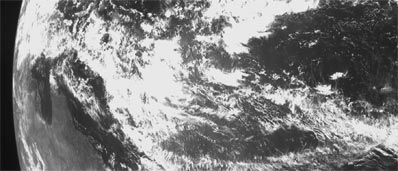Welcome !
Varun's Blog - At the Speed of Light !
A fact is a simple statement that everyone believes. It is innocent, unless found guilty. A hypothesis is a novel suggestion that no one wants to believe. It is guilty, until found effective. ~Edward Teller
A very warm welcome to my
Subscribe now
Sunday, November 09, 2008
Saturday, November 08, 2008
First Indian 'moon craft' ready to enter lunar orbit
The car-sized spacecraft will fire its liquid-fueled engine at about 1227 GMT (7:27 a.m. EST) Saturday to place Chandrayaan 1 in an oval-shaped parking orbit around the moon. That orbit will eventually be lowered to a circular path about 62 miles above the lunar surface.
 A view of Earth at an altitude of 9,000 km was taken by Chandrayaan 1's terrain mapping camera. Credit: ISRO See larger image here |
The probe has fired its engine five times since its Oct. 22 launch aboard a Polar Satellite Launch Vehicle dispatched from the Satish Dhawan Space Center on India's east coast.
The burns gradually raised the high point of Chandrayaan 1's orbit from about 14,200 miles to more than 235,000 miles, according to ISRO.
Controllers also turned on the probe's main camera at the end of October. The black-and-white stereo terrain mapping camera took pictures of Earth while zooming away from the planet.
Plans call for Chandrayaan 1 to release a 64-pound impactor around Nov. 15 for a suicidal nosedive into the moon. The trip from orbit to the lunar surface will take about a half-hour, and the small craft will relay imagery, altitude information and spectral data back to Earth through the Chandrayaan mother ship.
Chandrayaan means "moon craft" in Sanskrit, the ancient language of India.
The $80 million mission is India's answer to a pair of lunar missions launched last year by Japan and China. Both countries' moon orbiters are still collecting imagery and scientific data.
But unlike the Japanese and Chinese missions, India invited large contributions from other nations to put instruments on Chandrayaan 1. Scientists from Europe and the United States answered the call.
More than half of the probe's 11 instruments come from outside India. The European Space Agency spent $8 million to fund three payloads, while NASA provided two more sensors. Bulgarian scientists also contributed a radiation monitor to the mission.
Scientists expect data from Chandrayaan 1 to help create the most detailed global chemical map of the moon showing mineral concentrations across the lunar surface. Researchers will also make a three-dimensional terrain map of the moon based on information yielded by the mission.
The ESA-funded X-ray and near-infrared imaging spectrometers, called C1XS and SIR 2, will detect mineral signatures in soil on and just below the lunar surface. Both instruments are based on similar sensors that flew aboard Europe's SMART 1 spacecraft, which was deliberately crashed into the moon in 2006.
"The Apollo missions went down to the surface, but only in a limited number of spots, whereas Chandrayaan tries to do detailed imaging of the entire sphere of the moon," said Christian Erd, ESA's Chandrayaan 1 project manager.
"The opportunity to fly NASA instruments on Chandrayaan 1 undoubtedly will lead to important scientific discoveries," said Michael Griffin, NASA administrator. "This exciting collaboration represents an important next step in what we hope to be a long and mutually beneficial relationship with India in future civil space exploration."
The Moon Mineralogy Mapper, nicknamed M3, is a visual and near-infrared imaging spectrometer designed to plot mineral resources at higher resolutions than any instrument before. M3 scientists from the Jet Propulsion Laboratory hope the device will help them create mineral maps to find science-rich landing sites for future missions.
India's indigenous suite of science payloads include a terrain camera designed to take detailed black-and-white pictures of the whole lunar surface. The stereo camera will be able to spot features as small as about 16 feet, according to ISRO.
ISRO scientists also built two spectral imagers, one focusing on near-infrared and another in the X-ray range, to help produce precise global maps of the minerals and soil contents on the moon's surface.
A laser system was also bolted to the spacecraft to determine its altitude above the moon and chart lunar surface topography.
Indian engineers also constructed the moon impact probe.
"It has been the dream of Indian scientists to send a satellite around the moon and then collect more data about the surface features, minerals and so on," Nair said. "That dream is going to come true through this mission."
Source: Spaceflightnow.com
Posted by Varun Khetarpal 2 Opinions
This is science !
Photos of Comet Mcnaught !
Astro-photographer? Send your photos to pics@exploreuniverse.com and have them featured on this blog with your name. Comet Mcnaught : Pictures taken with Nikon D100 on 19/1/07 from Manning Point, northern NSW, Australia by Mr. Peter Enright.
Picture 1
Picture 2
Picture 3
Picture 4



